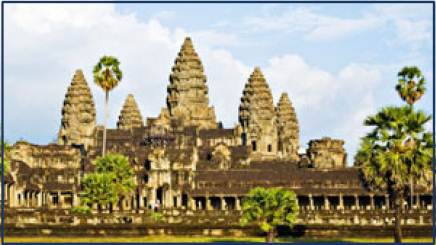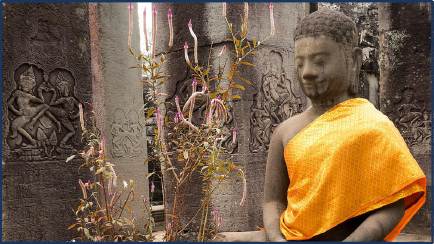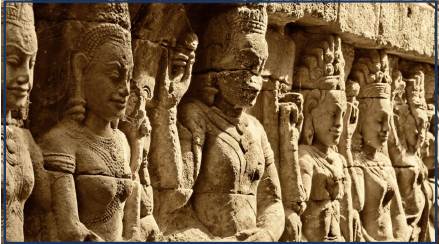| About Us | Site Map | Contact Us |
|
|
| Home | Schools & Teachings | Dharma Centers | Buddha & Bodhisattva Directory | Cosmos |
|
|
Buddhist Holy Sites in Other Countries
|
The two most prominent statues were the giant standing Buddhas Vairocana and Sakyamuni. The Buddha popularly called "Solsol" measures 53 meters tall,
and "Shahmama" 35 meters – the niches in which the figures stand are 58 and 38 meters from bottom to top.
Angkor Thom was established as the capital of Jayavarman VII's Khmer empire, and was the centre of his massive building programme.
Most of the great Angkor ruins have vast displays of bas-relief depicting the various gods, goddesses, and other-worldly beings from the
mythological stories and epic poems of ancient Hinduism (modified by centuries of Buddhism).



The temple's official name is Preah Vihear Preah Keo Morakot but is commonly referred to as Wat Preah Keo in Khmer.
The vihara houses many national treasures such as gold and jeweled Buddha statues.
Most notable is a small 17th century baccarat crystal Buddha (the "Emerald Buddha" of Cambodia) and a life-sized
gold Maitreya Buddha decorated with 9584 diamonds
Borobudur (Barabudur), a 9th-century Mahayana Buddhist Temple in Central Java, Indonesia, consists of six square platforms.
These platforms are topped by three circular platforms, and is decorated with 2,672 relief panels and 504 Buddha statues.
Mendut is the oldest of the three temples including Pawon and Borobudur.
The temple was built and finished during the reign of King Indra of Sailendra dynasty, dated 824 AD.
The square terrace surrounding the body of the temple was meant for pradakshina or circumambulating ritual,
walking clockwise around the temple. The outer walls is adorned with bas-reliefs of Boddhisattvas such as Avalokitesvara,
Maitreya, Cunda, Ksitigarbha, Samantabhadra, Mahakarunika Avalokitesvara, Vajrapani, Manjusri,
Akasagarbha, and Boddhisattvadevi Prajnaparamita among other buddhist figures.
Candi Sewu is the 2nd largest Buddhist Temple in Central Java after Borobudur. Its in Javanese translates to "a thousand temples".
According to the legend, the original name of this temple compound is probably Manjusrigrha (The House of Manjusri).
Sewu Temple was probably built in the 8th century at the end of Rakai Panangkaran (746 – 784 AD) administration.
There are a total of 249 buildings in the complex arranged in a Mandala pattern around the central main hall expressing
the view of the universe of Mahayana Buddhism.
From the 9th to 13th centuries, the city was the capital of the Kingdom of Pagan. During the kingdom's height between the
11th and 13th centuries, over 10,000 Buddhist temples, pagodas and monasteries were constructed in the Bagan plains alone,
of which the remains of over 2200 temples and pagodas still survive to the present day.
The culture of Bagan was dominated by religion where Theravada Buddhism co-existed with Mahayana Buddhism, Tantric Buddhism,
various Hindu (Saivite, and Vaishana) schools as well as native animist (nat) traditions.
Kyaiktiyo Pagoda (a.k.a. Golden Rock) is a small pagoda (7.3 metres, 24 ft) built on the top of a granite boulder covered with gold leaves pasted on by devotees.
According to legend, the Golden Rock itself is precariously perched on a strand of the Buddha's hair.
The rock and the pagoda are at the top of Mt. Kyaiktiyo. It is the third most important Buddhist pilgrimage site in Burma after the Shwedagon Pagoda and the Mahamuni Buddha Temple.
The Shwedagon Pagoda (officially, Shwedagon Zedi Daw), also known as the Great Dagon Pagoda and the Golden Pagoda.
It is a 99 metres (325 ft) gilded pagoda and stupa located in Yangon, Burma.
According to legend, this Pagoda has existed for more than 2,600 years, making it the oldest historical pagoda in Burma and the world.
It was told that two merchant brothers, Taphussa and Bhallika, from the land of Ramanya, met the Lord Gautama Buddha during his lifetime and received eight of the Buddha's hairs in 588 BC.
The brothers traveled back to their homeland and built this Pagoda with the help of King Okkalapa.
Ancient tradition refers to only five likenesses of the Buddha that were made during his lifetime: two were in India, two in paradise,
and the fifth is the Mahamuni Buddha image in Myanmar.
According to the legend, the Buddha visited the Dhanyawadi city of Arakan in 554 BC. King Sanda Thuriya requested that an image was cast of him.
The exact likeness of this Mahamuni Buddha image (The Great Sage) was later moved from Arakan to this temple.
The Wat Phra Kaew or Wat Phra Si Rattana Satsadaram (Temple of the Emerald Buddha) is the most sacred Buddhist temple (wat) in Thailand.
According to the legend, this Buddha image is traced to India, five centuries after the Lord Buddha attained Nirvana, it was enshrined in Bangkok at the Wat Phra Kaew temple in 1782.
|
| About Us | Free Books | Site Map | Contact Us | ||
| Copyright © 1999-2020 Manjushri. All Rights Reserved. | ||
